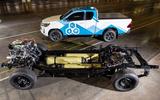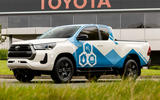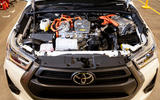Toyota has taken a major step in the development of hydrogen propulsion with the unveiling of a prototype Toyota Hilux fuel cell electric vehicle (FCEV).
Although the company’s first FCEV was a car (the Toyota Mirai, on sale since 2014 and now into its second generation), commercial vehicles’ need for quicker refuelling and longer range than batteries can presently provide makes them a better fit for the technology.
Toyota’s FCEV pick-up truck has a simulated range of 365 miles and a refuelling time similar to that of a diesel. The project – which was funded, developed and delivered in the UK at Toyota’s Burnaston plant – was given the go-ahead in just 12 months.
Toyota won’t share the Hilux FCEV’s weight or payload until development is done, at which point it will also reveal whether it will go into production.
Development
A team of engineers from Toyota and specialists from Ricardo, European Thermodynamics, D2H Advanced Technologies and Thatcham Research adapted 10 Hilux development vehicles to accept the Mirai’s powertrain and fuelling system.

One has been crash tested while on-road development continues with the others ahead of test vehicles being placed with potential customers, who include emergency services.
Despite the emergence of native FCEV truck makers Tevva and Hydrogen Vehicle Systems and the availability of FCEV cars (most notably the Mirai and Hyundai Nexo), the UK has been relatively slow to embrace hydrogen.
Turning the Hilux into a hydrogen vehicle
Outwardly, the new FCEV looks no different from a regular 2.4-litre diesel Hilux. Opening the bonnet, however, reveals the Mirai-sourced fuel cell stack.
Behind the cab bulkhead is a reinforced metal box containing a battery about the same size as that in a hybrid car.
This accounts for around 20% of the deck’s total area, but Toyota said it could be located under the rear seats on regular models. Underneath are three large cylinders, each containing 2.6kg of hydrogen (a typical FCEV car uses 1kg per day, costing around £15), and towards the rear is a Miraisourced electric motor.
Toyota Motor Europe’s head of powertrains, Timothy D’Herde, said: “We tried to keep the ground clearance of the regular Hilux. However, customers said they wanted to see and try something as soon as possible, so we used proven Mirai components, which have had an impact on ground clearance.
“Now we need to see the vehicle in its natural habitat. Some customers may say they need four-wheel drive, in which case we will need more ground clearance.”

The modularity of the fuel stack is one of its most appealing features, said D’Herde. So is its flexibility, it having been used elsewhere in applications ranging from static power generation to powering converted VDL Group delivery trucks for Toyota’s logistical activities.
Its installation in the Hilux raised all sorts of challenges, however, explained D’Herde: “The Hilux’s engine bay tapers from front to back, while to help the water to drain, the stack is angled downwards slightly.
“All this made fitting ancillaries such as the air compressor, intercooler and air cleaner a real challenge. Cooling power is critical: in an internal combustion engine, a lot of the heat goes through the exhaust, but the exhaust in a fuel cell stack is [only] water, so we need a lot of heat exchangers to manage the heat. We designed a bespoke radiator to help with that.”
The team also had to reconfigure the ladder-frame chassis to accommodate the three large hydrogen cylinders. “We visited Toyota plants to study their production processes, including those for the hydrogen tanks, with fuel safety being our primary focus,” said D’Herde. “Then, having understood the frame’s design, the team decided how to make space in it for the tanks without affecting its strength and safety.
“Our South African plant, where the Hilux is made [for Europe], then built and mounted bodies onto them.”
Hydrogen adoption
At the launch of the Hilux FCEV prototype, Toyota GB president Agustín Martín emphasised the firm’s 30-year history of developing hydrogen fuel cell technology.
However, he added that although the company had sold 25,000 FCEVs worldwide, it alone couldn’t lead the transition and there were challenges ahead.
He said: “Our company can’t make hydrogen happen. It’s essential there is a long-term national strategy in which hydrogen is not disadvantaged. A [hydrogen] fuel production and delivery infrastructure and government-supported vehicle purchase incentives will be necessary.”
Until then, the challenge will be to identify a need for hydrogen and develop vehicles that can fulfil it – and with the Hilux FCEV, Toyota believes it could be onto a winner.
“Demand is confirmed: we know the vehicle meets customers’ requirements for quick refuelling and longer range and the powertrain is proven,” said Timothy D’Herde, Toyota Motor Europe’s head of powertrains.













Join the debate
Add your comment
Is this really a major step in hydrogen car prolpulsion, taking an engine from a Mira and putting it in a truck. I notice there's no pictures of the bed. Anyhow in the 6 months it took to knock up Ford knocked out 10,000 lightings.
As to the comment a typical hydrogen car uses a kilo a day at 15 quid, it means nothing.
hy
Quite a lot of these HiLux's are used in the heavy construction industry, ( they arent all used by farmers and Gamekeepers).
Toyota can see that with JCB leading the way with Hydrogen being seen as the way forward, electric not working in this Industry, there will be many big companies with Hydrogen refueling on-site.